Macroeconomics and Behavioural Economics: Understanding the Law of Demand and Supply, and Modern Business Practices
VerifiedAdded on 2023/06/10
|15
|3408
|260
AI Summary
This report explains the law of demand and supply along with the movement and shifts in their curves with influencing factors. It also discusses modern and traditional theories in relation to modern business practices. The report is useful for understanding the macroeconomic and behavioural economic principles and their application in the business world.
Contribute Materials
Your contribution can guide someone’s learning journey. Share your
documents today.
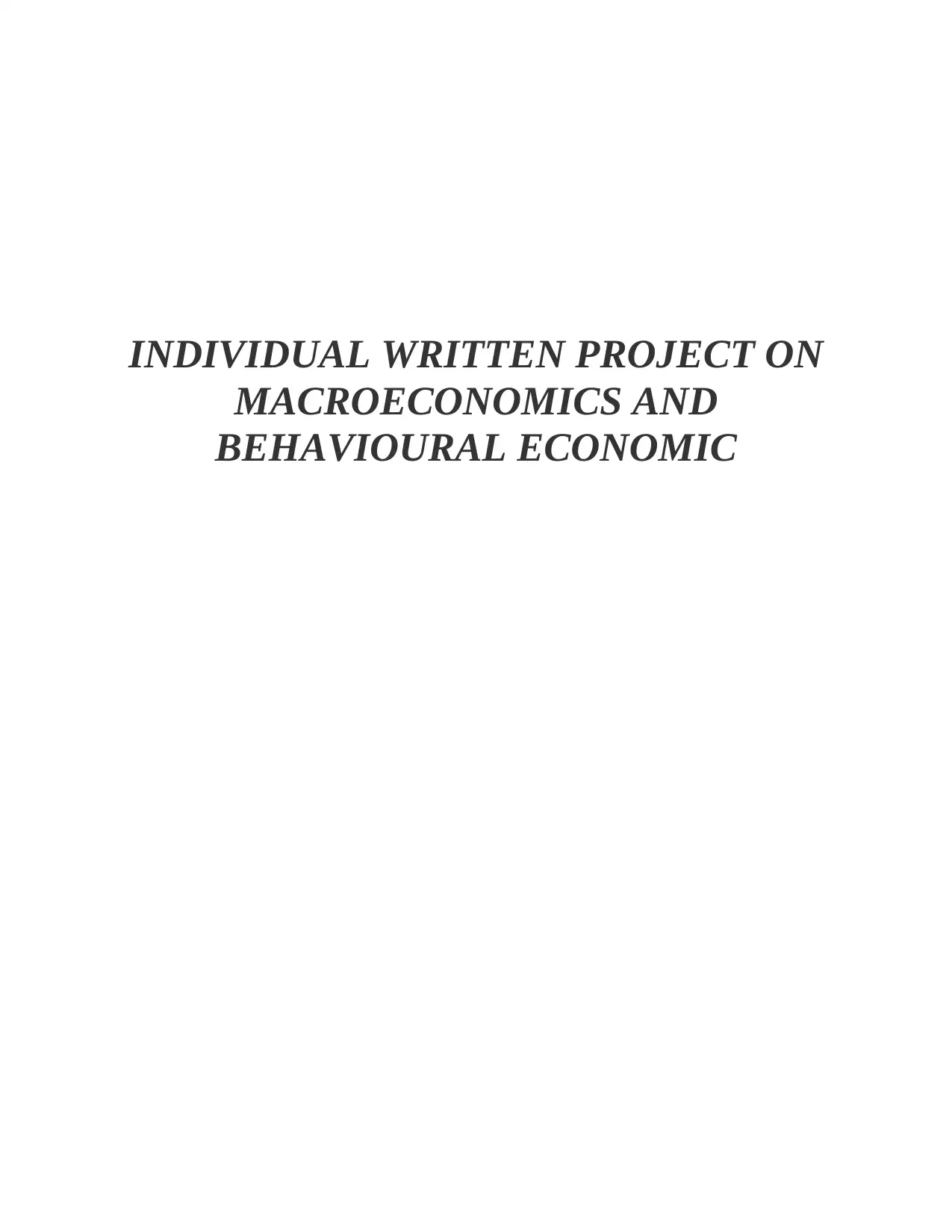
INDIVIDUAL WRITTEN PROJECT ON
MACROECONOMICS AND
BEHAVIOURAL ECONOMIC
MACROECONOMICS AND
BEHAVIOURAL ECONOMIC
Secure Best Marks with AI Grader
Need help grading? Try our AI Grader for instant feedback on your assignments.
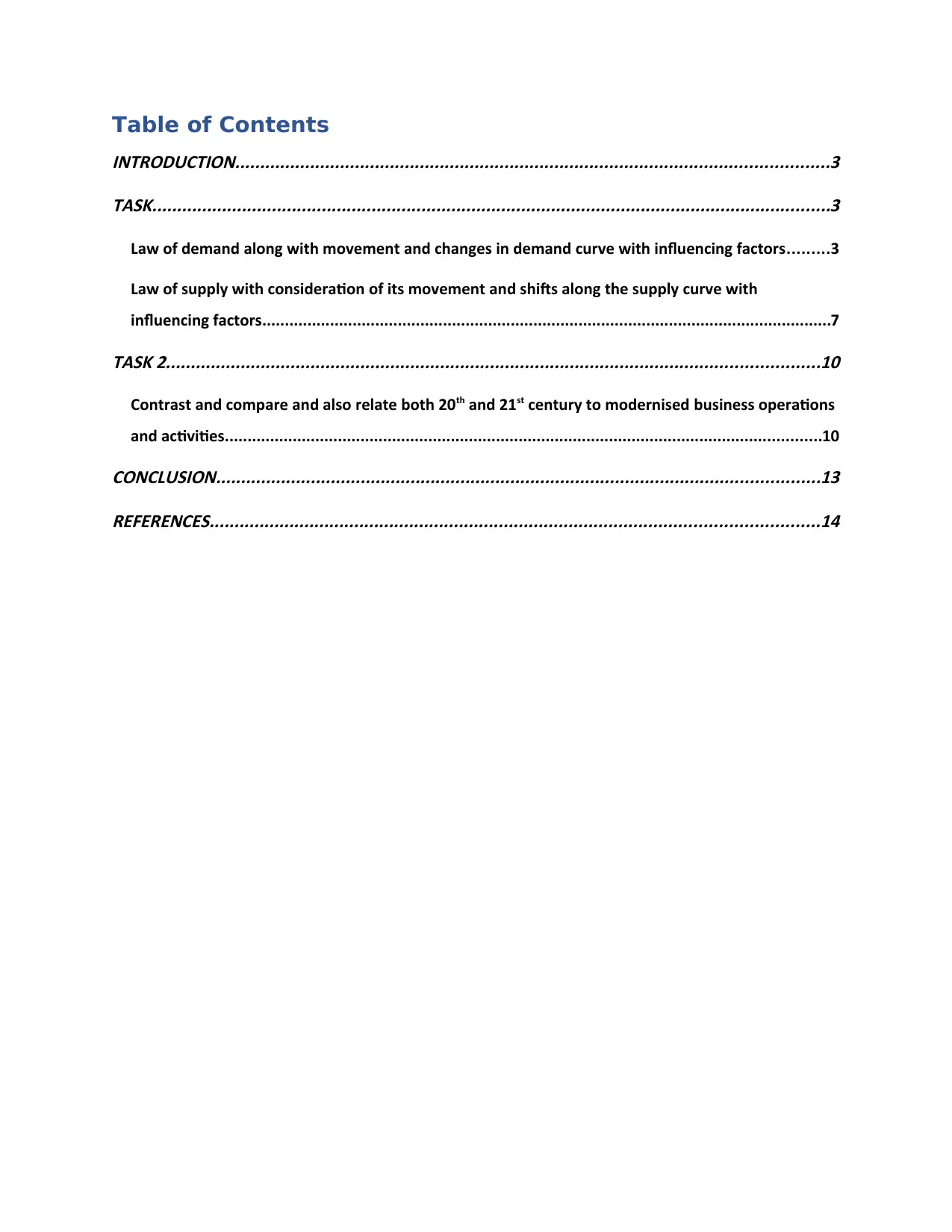
Table of ContentsINTRODUCTION.......................................................................................................................3
TASK........................................................................................................................................3
Law of demand along with movement and changes in demand curve with influencing factors.........3
Law of supply with consideration of its movement and shifts along the supply curve with
influencing factors..............................................................................................................................7
TASK 2...................................................................................................................................10
Contrast and compare and also relate both 20th and 21st century to modernised business operations
and activities....................................................................................................................................10
CONCLUSION.........................................................................................................................13
REFERENCES..........................................................................................................................14
TASK........................................................................................................................................3
Law of demand along with movement and changes in demand curve with influencing factors.........3
Law of supply with consideration of its movement and shifts along the supply curve with
influencing factors..............................................................................................................................7
TASK 2...................................................................................................................................10
Contrast and compare and also relate both 20th and 21st century to modernised business operations
and activities....................................................................................................................................10
CONCLUSION.........................................................................................................................13
REFERENCES..........................................................................................................................14
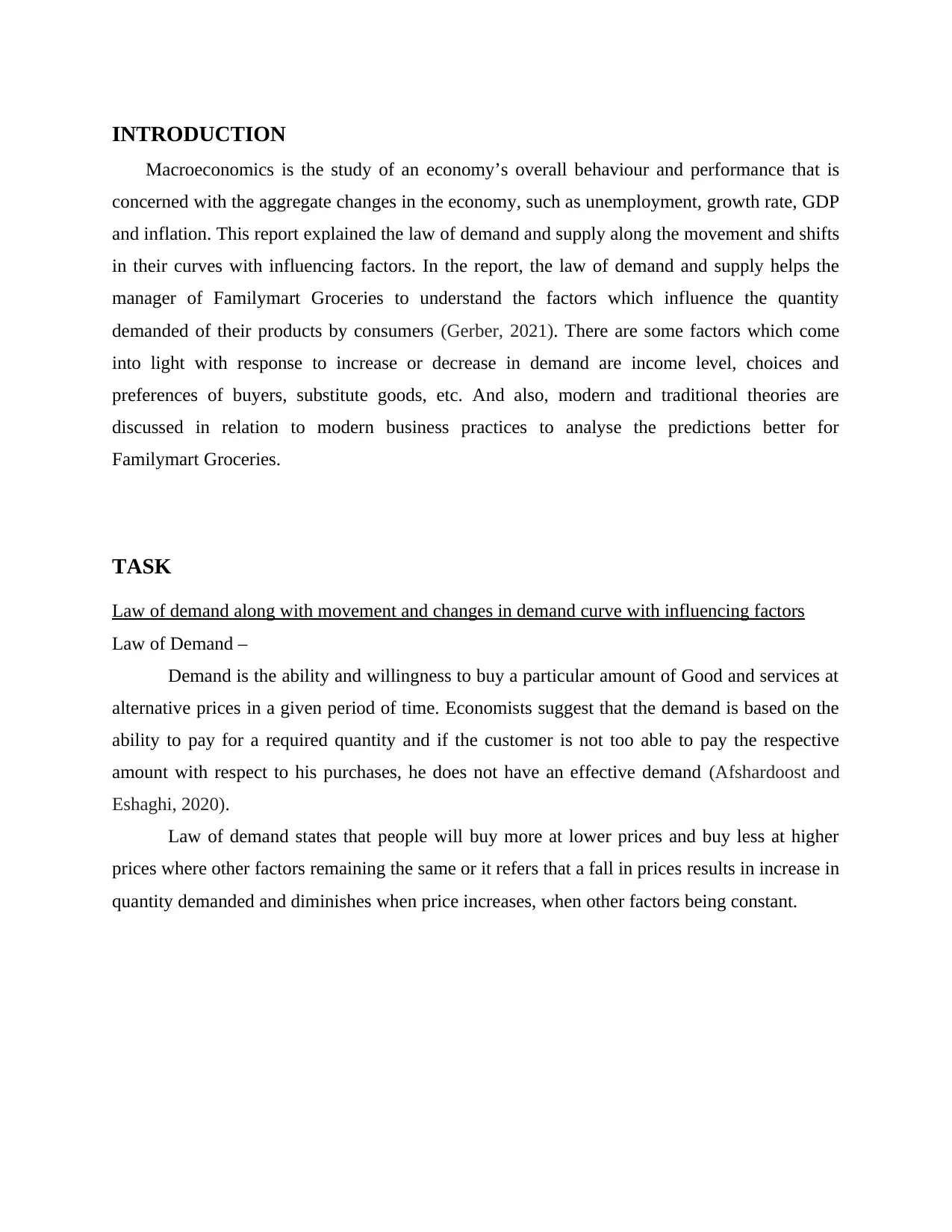
INTRODUCTION
Macroeconomics is the study of an economy’s overall behaviour and performance that is
concerned with the aggregate changes in the economy, such as unemployment, growth rate, GDP
and inflation. This report explained the law of demand and supply along the movement and shifts
in their curves with influencing factors. In the report, the law of demand and supply helps the
manager of Familymart Groceries to understand the factors which influence the quantity
demanded of their products by consumers (Gerber, 2021). There are some factors which come
into light with response to increase or decrease in demand are income level, choices and
preferences of buyers, substitute goods, etc. And also, modern and traditional theories are
discussed in relation to modern business practices to analyse the predictions better for
Familymart Groceries.
TASK
Law of demand along with movement and changes in demand curve with influencing factors
Law of Demand –
Demand is the ability and willingness to buy a particular amount of Good and services at
alternative prices in a given period of time. Economists suggest that the demand is based on the
ability to pay for a required quantity and if the customer is not too able to pay the respective
amount with respect to his purchases, he does not have an effective demand (Afshardoost and
Eshaghi, 2020).
Law of demand states that people will buy more at lower prices and buy less at higher
prices where other factors remaining the same or it refers that a fall in prices results in increase in
quantity demanded and diminishes when price increases, when other factors being constant.
Macroeconomics is the study of an economy’s overall behaviour and performance that is
concerned with the aggregate changes in the economy, such as unemployment, growth rate, GDP
and inflation. This report explained the law of demand and supply along the movement and shifts
in their curves with influencing factors. In the report, the law of demand and supply helps the
manager of Familymart Groceries to understand the factors which influence the quantity
demanded of their products by consumers (Gerber, 2021). There are some factors which come
into light with response to increase or decrease in demand are income level, choices and
preferences of buyers, substitute goods, etc. And also, modern and traditional theories are
discussed in relation to modern business practices to analyse the predictions better for
Familymart Groceries.
TASK
Law of demand along with movement and changes in demand curve with influencing factors
Law of Demand –
Demand is the ability and willingness to buy a particular amount of Good and services at
alternative prices in a given period of time. Economists suggest that the demand is based on the
ability to pay for a required quantity and if the customer is not too able to pay the respective
amount with respect to his purchases, he does not have an effective demand (Afshardoost and
Eshaghi, 2020).
Law of demand states that people will buy more at lower prices and buy less at higher
prices where other factors remaining the same or it refers that a fall in prices results in increase in
quantity demanded and diminishes when price increases, when other factors being constant.
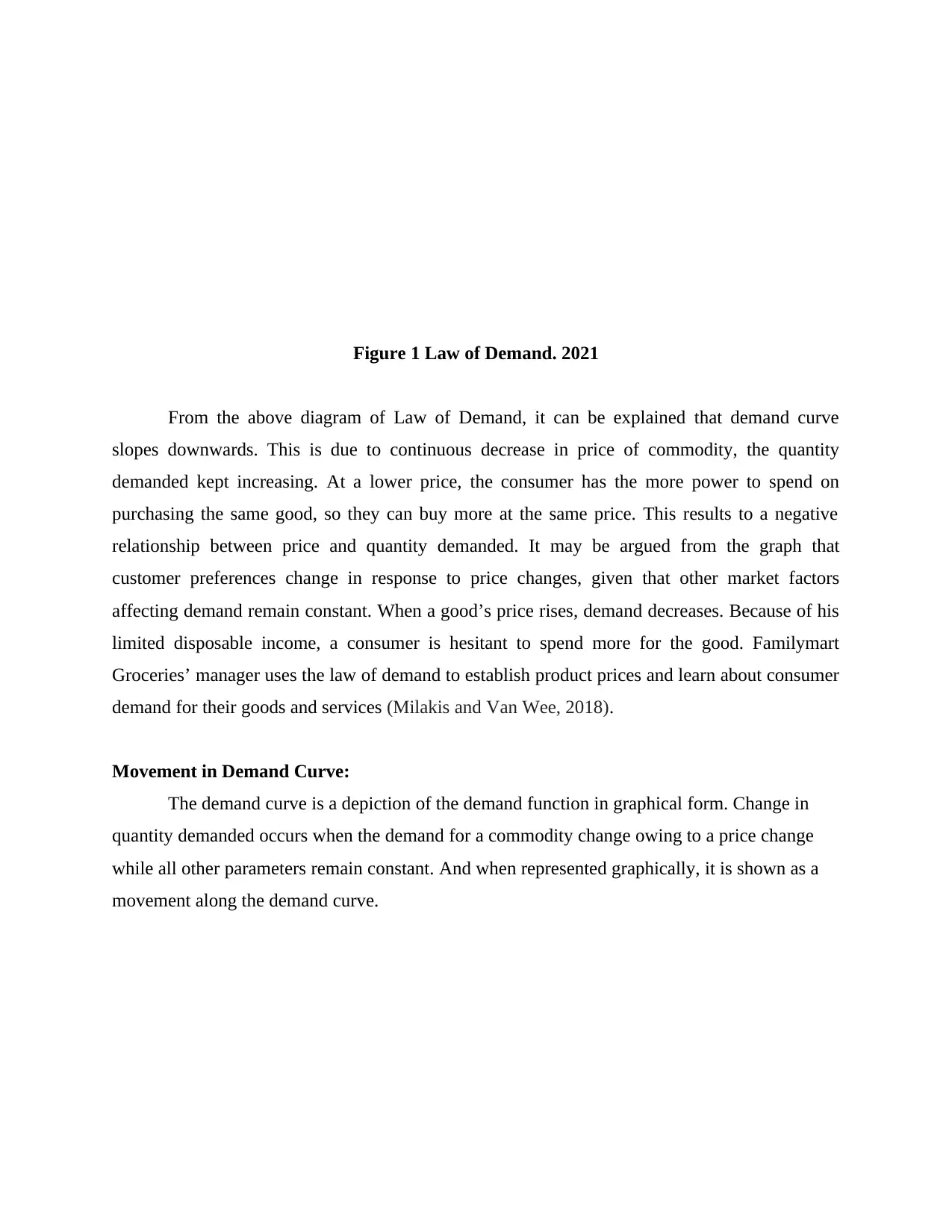
Figure 1 Law of Demand. 2021
From the above diagram of Law of Demand, it can be explained that demand curve
slopes downwards. This is due to continuous decrease in price of commodity, the quantity
demanded kept increasing. At a lower price, the consumer has the more power to spend on
purchasing the same good, so they can buy more at the same price. This results to a negative
relationship between price and quantity demanded. It may be argued from the graph that
customer preferences change in response to price changes, given that other market factors
affecting demand remain constant. When a good’s price rises, demand decreases. Because of his
limited disposable income, a consumer is hesitant to spend more for the good. Familymart
Groceries’ manager uses the law of demand to establish product prices and learn about consumer
demand for their goods and services (Milakis and Van Wee, 2018).
Movement in Demand Curve:
The demand curve is a depiction of the demand function in graphical form. Change in
quantity demanded occurs when the demand for a commodity change owing to a price change
while all other parameters remain constant. And when represented graphically, it is shown as a
movement along the demand curve.
From the above diagram of Law of Demand, it can be explained that demand curve
slopes downwards. This is due to continuous decrease in price of commodity, the quantity
demanded kept increasing. At a lower price, the consumer has the more power to spend on
purchasing the same good, so they can buy more at the same price. This results to a negative
relationship between price and quantity demanded. It may be argued from the graph that
customer preferences change in response to price changes, given that other market factors
affecting demand remain constant. When a good’s price rises, demand decreases. Because of his
limited disposable income, a consumer is hesitant to spend more for the good. Familymart
Groceries’ manager uses the law of demand to establish product prices and learn about consumer
demand for their goods and services (Milakis and Van Wee, 2018).
Movement in Demand Curve:
The demand curve is a depiction of the demand function in graphical form. Change in
quantity demanded occurs when the demand for a commodity change owing to a price change
while all other parameters remain constant. And when represented graphically, it is shown as a
movement along the demand curve.
Secure Best Marks with AI Grader
Need help grading? Try our AI Grader for instant feedback on your assignments.
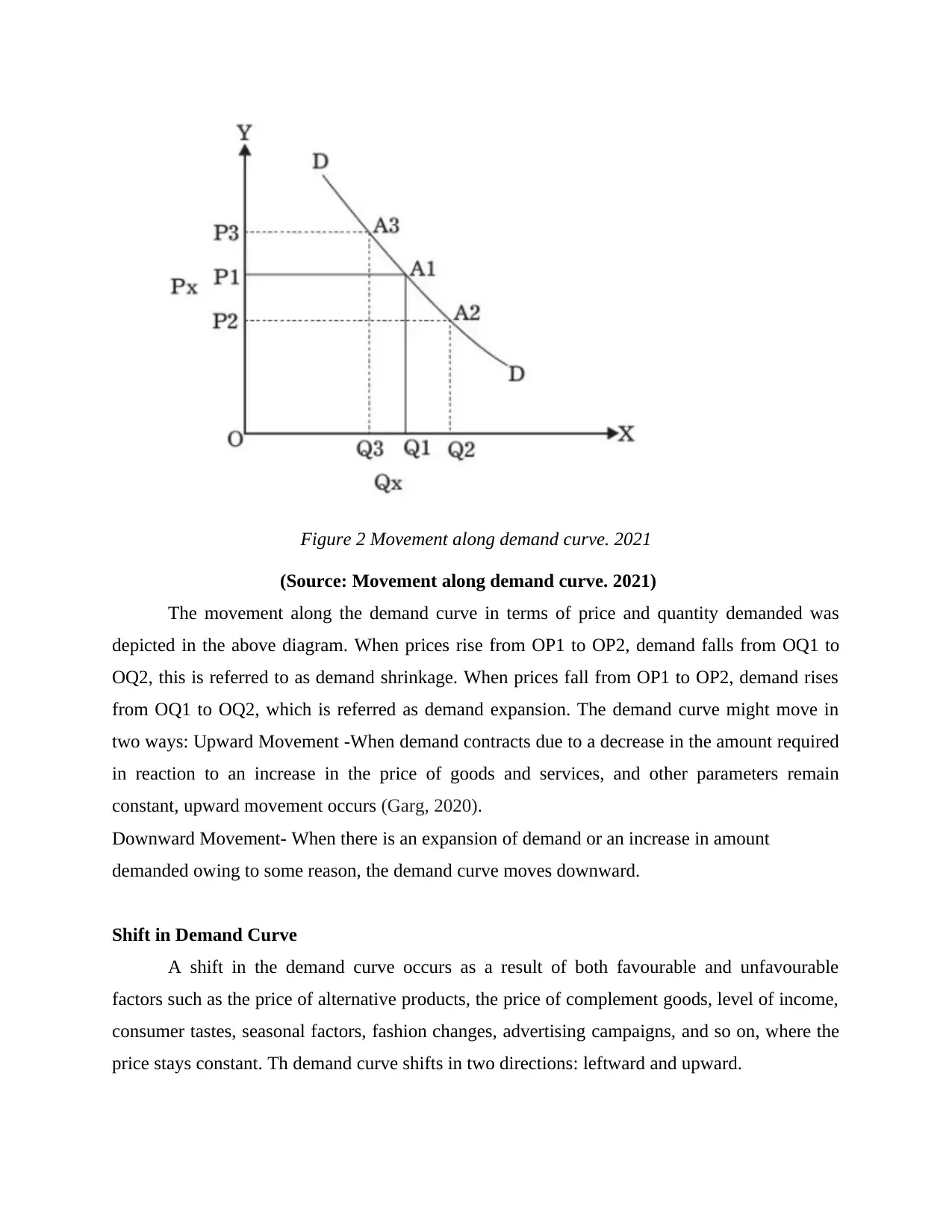
Figure 2 Movement along demand curve. 2021
(Source: Movement along demand curve. 2021)
The movement along the demand curve in terms of price and quantity demanded was
depicted in the above diagram. When prices rise from OP1 to OP2, demand falls from OQ1 to
OQ2, this is referred to as demand shrinkage. When prices fall from OP1 to OP2, demand rises
from OQ1 to OQ2, which is referred as demand expansion. The demand curve might move in
two ways: Upward Movement -When demand contracts due to a decrease in the amount required
in reaction to an increase in the price of goods and services, and other parameters remain
constant, upward movement occurs (Garg, 2020).
Downward Movement- When there is an expansion of demand or an increase in amount
demanded owing to some reason, the demand curve moves downward.
Shift in Demand Curve
A shift in the demand curve occurs as a result of both favourable and unfavourable
factors such as the price of alternative products, the price of complement goods, level of income,
consumer tastes, seasonal factors, fashion changes, advertising campaigns, and so on, where the
price stays constant. Th demand curve shifts in two directions: leftward and upward.
(Source: Movement along demand curve. 2021)
The movement along the demand curve in terms of price and quantity demanded was
depicted in the above diagram. When prices rise from OP1 to OP2, demand falls from OQ1 to
OQ2, this is referred to as demand shrinkage. When prices fall from OP1 to OP2, demand rises
from OQ1 to OQ2, which is referred as demand expansion. The demand curve might move in
two ways: Upward Movement -When demand contracts due to a decrease in the amount required
in reaction to an increase in the price of goods and services, and other parameters remain
constant, upward movement occurs (Garg, 2020).
Downward Movement- When there is an expansion of demand or an increase in amount
demanded owing to some reason, the demand curve moves downward.
Shift in Demand Curve
A shift in the demand curve occurs as a result of both favourable and unfavourable
factors such as the price of alternative products, the price of complement goods, level of income,
consumer tastes, seasonal factors, fashion changes, advertising campaigns, and so on, where the
price stays constant. Th demand curve shifts in two directions: leftward and upward.
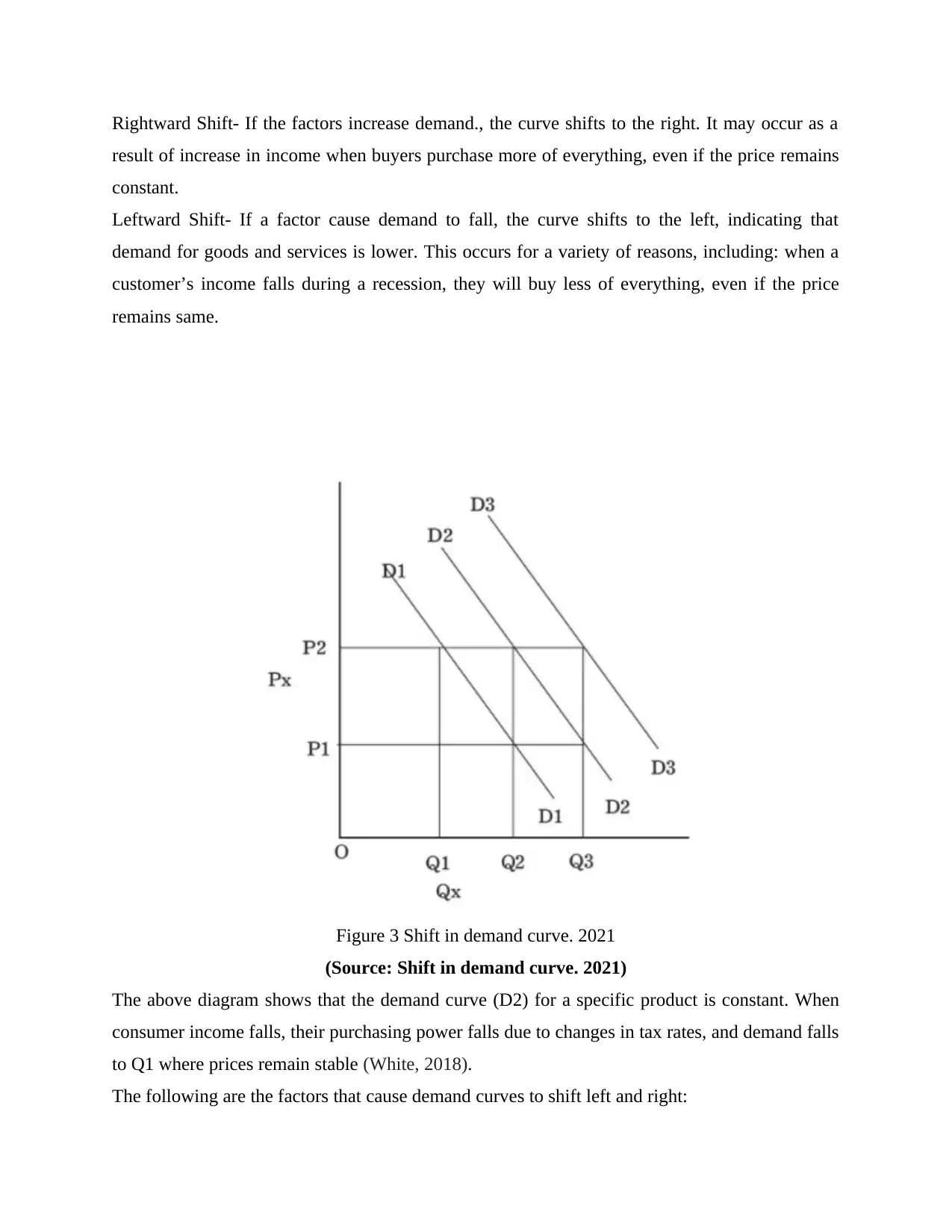
Rightward Shift- If the factors increase demand., the curve shifts to the right. It may occur as a
result of increase in income when buyers purchase more of everything, even if the price remains
constant.
Leftward Shift- If a factor cause demand to fall, the curve shifts to the left, indicating that
demand for goods and services is lower. This occurs for a variety of reasons, including: when a
customer’s income falls during a recession, they will buy less of everything, even if the price
remains same.
Figure 3 Shift in demand curve. 2021
(Source: Shift in demand curve. 2021)
The above diagram shows that the demand curve (D2) for a specific product is constant. When
consumer income falls, their purchasing power falls due to changes in tax rates, and demand falls
to Q1 where prices remain stable (White, 2018).
The following are the factors that cause demand curves to shift left and right:
result of increase in income when buyers purchase more of everything, even if the price remains
constant.
Leftward Shift- If a factor cause demand to fall, the curve shifts to the left, indicating that
demand for goods and services is lower. This occurs for a variety of reasons, including: when a
customer’s income falls during a recession, they will buy less of everything, even if the price
remains same.
Figure 3 Shift in demand curve. 2021
(Source: Shift in demand curve. 2021)
The above diagram shows that the demand curve (D2) for a specific product is constant. When
consumer income falls, their purchasing power falls due to changes in tax rates, and demand falls
to Q1 where prices remain stable (White, 2018).
The following are the factors that cause demand curves to shift left and right:
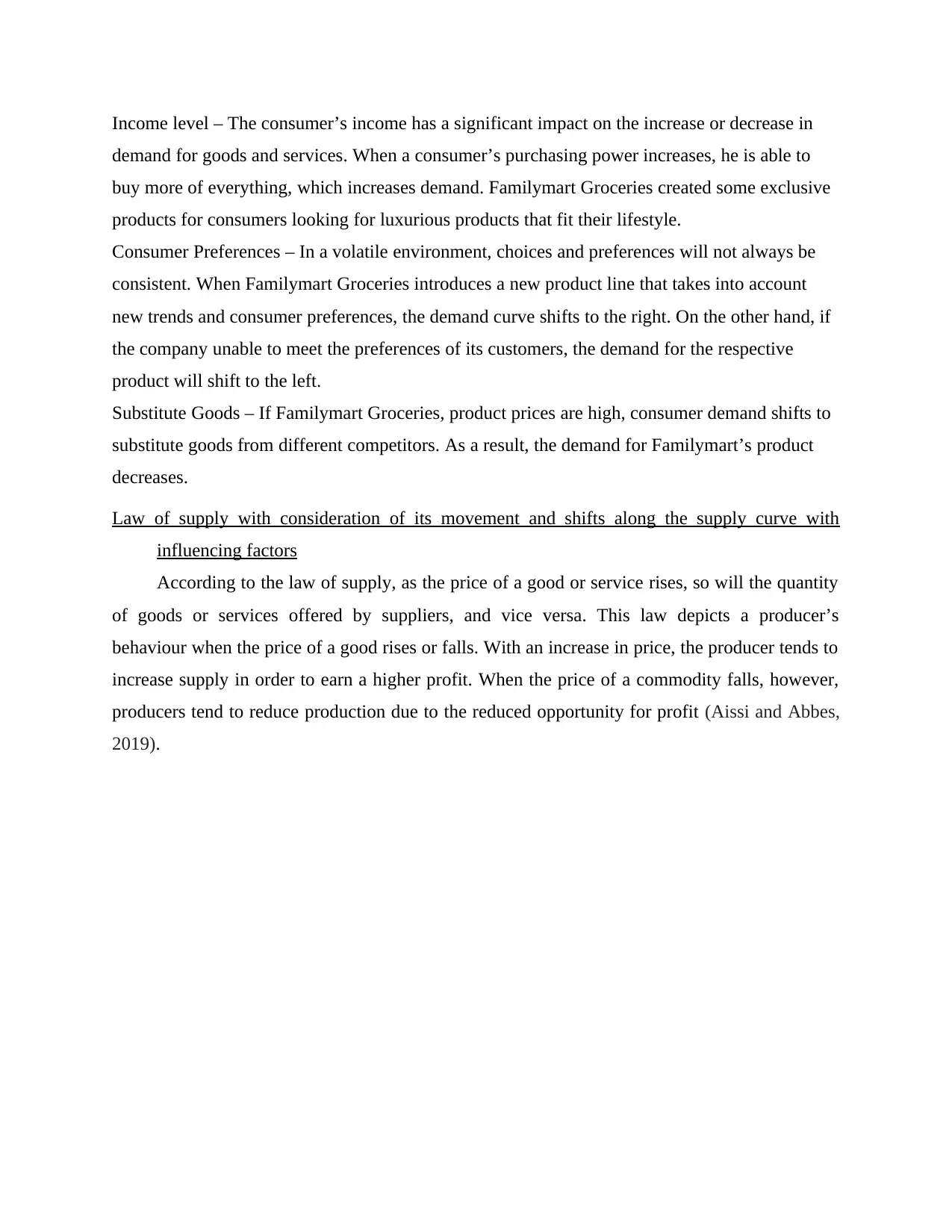
Income level – The consumer’s income has a significant impact on the increase or decrease in
demand for goods and services. When a consumer’s purchasing power increases, he is able to
buy more of everything, which increases demand. Familymart Groceries created some exclusive
products for consumers looking for luxurious products that fit their lifestyle.
Consumer Preferences – In a volatile environment, choices and preferences will not always be
consistent. When Familymart Groceries introduces a new product line that takes into account
new trends and consumer preferences, the demand curve shifts to the right. On the other hand, if
the company unable to meet the preferences of its customers, the demand for the respective
product will shift to the left.
Substitute Goods – If Familymart Groceries, product prices are high, consumer demand shifts to
substitute goods from different competitors. As a result, the demand for Familymart’s product
decreases.
Law of supply with consideration of its movement and shifts along the supply curve with
influencing factors
According to the law of supply, as the price of a good or service rises, so will the quantity
of goods or services offered by suppliers, and vice versa. This law depicts a producer’s
behaviour when the price of a good rises or falls. With an increase in price, the producer tends to
increase supply in order to earn a higher profit. When the price of a commodity falls, however,
producers tend to reduce production due to the reduced opportunity for profit (Aissi and Abbes,
2019).
demand for goods and services. When a consumer’s purchasing power increases, he is able to
buy more of everything, which increases demand. Familymart Groceries created some exclusive
products for consumers looking for luxurious products that fit their lifestyle.
Consumer Preferences – In a volatile environment, choices and preferences will not always be
consistent. When Familymart Groceries introduces a new product line that takes into account
new trends and consumer preferences, the demand curve shifts to the right. On the other hand, if
the company unable to meet the preferences of its customers, the demand for the respective
product will shift to the left.
Substitute Goods – If Familymart Groceries, product prices are high, consumer demand shifts to
substitute goods from different competitors. As a result, the demand for Familymart’s product
decreases.
Law of supply with consideration of its movement and shifts along the supply curve with
influencing factors
According to the law of supply, as the price of a good or service rises, so will the quantity
of goods or services offered by suppliers, and vice versa. This law depicts a producer’s
behaviour when the price of a good rises or falls. With an increase in price, the producer tends to
increase supply in order to earn a higher profit. When the price of a commodity falls, however,
producers tend to reduce production due to the reduced opportunity for profit (Aissi and Abbes,
2019).
Paraphrase This Document
Need a fresh take? Get an instant paraphrase of this document with our AI Paraphraser
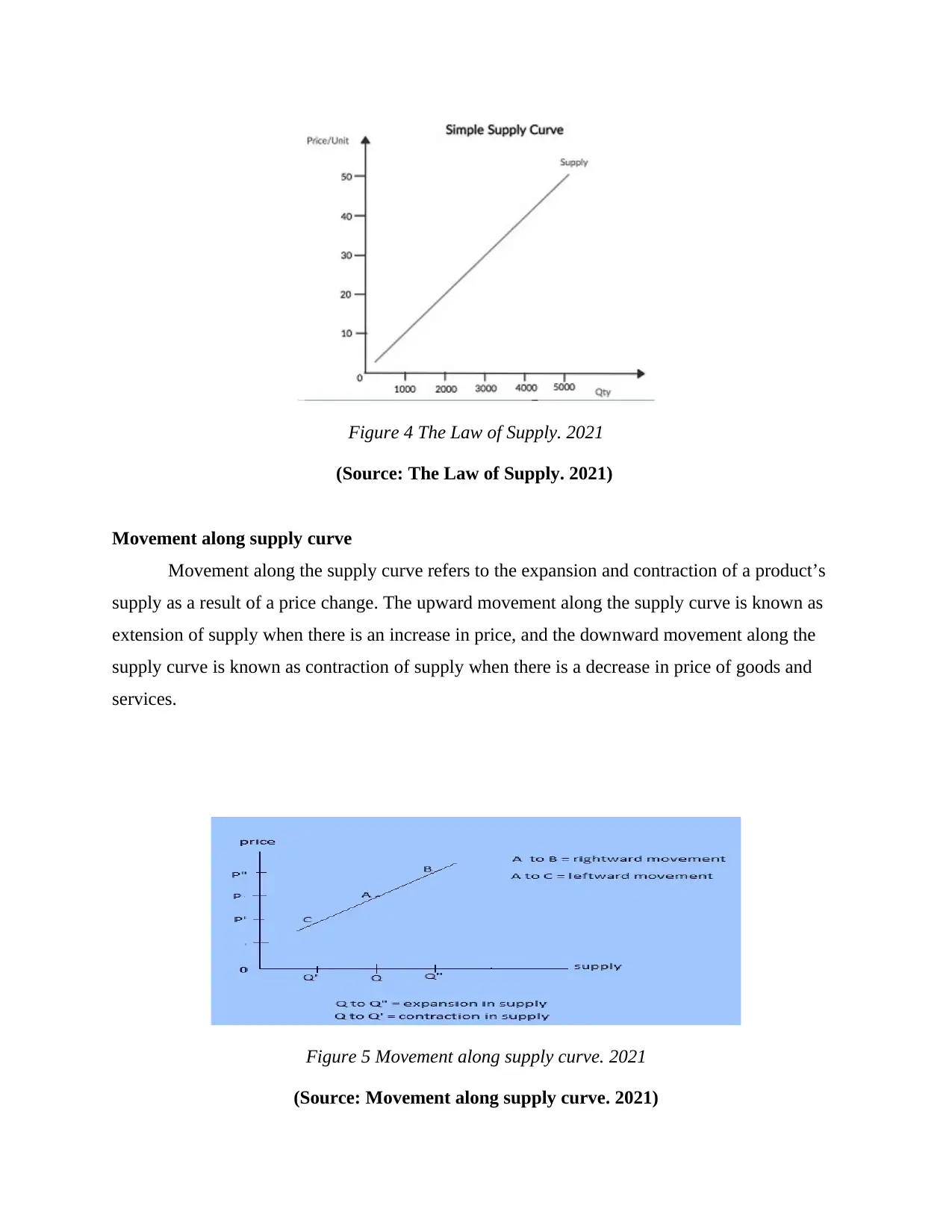
Figure 4 The Law of Supply. 2021
(Source: The Law of Supply. 2021)
Movement along supply curve
Movement along the supply curve refers to the expansion and contraction of a product’s
supply as a result of a price change. The upward movement along the supply curve is known as
extension of supply when there is an increase in price, and the downward movement along the
supply curve is known as contraction of supply when there is a decrease in price of goods and
services.
Figure 5 Movement along supply curve. 2021
(Source: Movement along supply curve. 2021)
(Source: The Law of Supply. 2021)
Movement along supply curve
Movement along the supply curve refers to the expansion and contraction of a product’s
supply as a result of a price change. The upward movement along the supply curve is known as
extension of supply when there is an increase in price, and the downward movement along the
supply curve is known as contraction of supply when there is a decrease in price of goods and
services.
Figure 5 Movement along supply curve. 2021
(Source: Movement along supply curve. 2021)
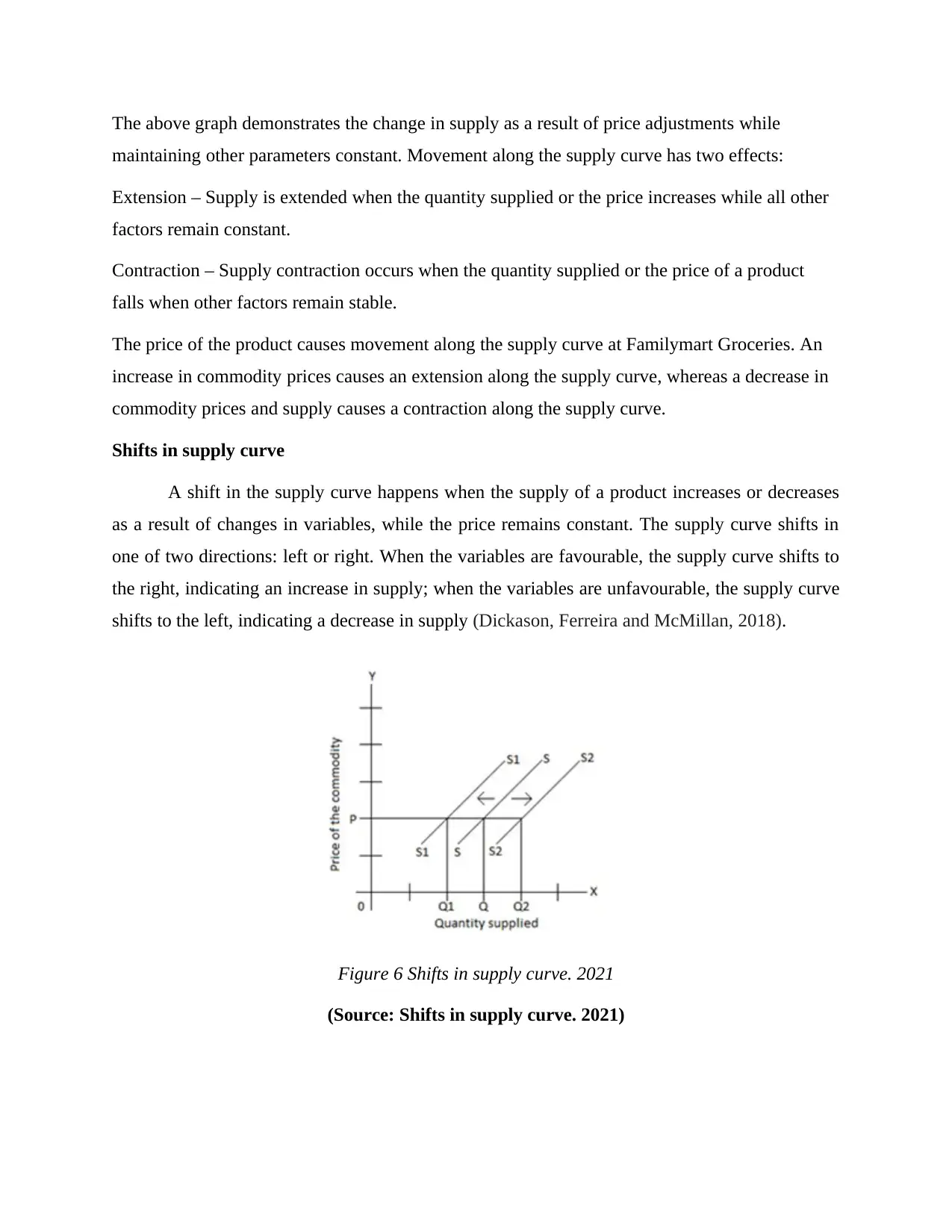
The above graph demonstrates the change in supply as a result of price adjustments while
maintaining other parameters constant. Movement along the supply curve has two effects:
Extension – Supply is extended when the quantity supplied or the price increases while all other
factors remain constant.
Contraction – Supply contraction occurs when the quantity supplied or the price of a product
falls when other factors remain stable.
The price of the product causes movement along the supply curve at Familymart Groceries. An
increase in commodity prices causes an extension along the supply curve, whereas a decrease in
commodity prices and supply causes a contraction along the supply curve.
Shifts in supply curve
A shift in the supply curve happens when the supply of a product increases or decreases
as a result of changes in variables, while the price remains constant. The supply curve shifts in
one of two directions: left or right. When the variables are favourable, the supply curve shifts to
the right, indicating an increase in supply; when the variables are unfavourable, the supply curve
shifts to the left, indicating a decrease in supply (Dickason, Ferreira and McMillan, 2018).
Figure 6 Shifts in supply curve. 2021
(Source: Shifts in supply curve. 2021)
maintaining other parameters constant. Movement along the supply curve has two effects:
Extension – Supply is extended when the quantity supplied or the price increases while all other
factors remain constant.
Contraction – Supply contraction occurs when the quantity supplied or the price of a product
falls when other factors remain stable.
The price of the product causes movement along the supply curve at Familymart Groceries. An
increase in commodity prices causes an extension along the supply curve, whereas a decrease in
commodity prices and supply causes a contraction along the supply curve.
Shifts in supply curve
A shift in the supply curve happens when the supply of a product increases or decreases
as a result of changes in variables, while the price remains constant. The supply curve shifts in
one of two directions: left or right. When the variables are favourable, the supply curve shifts to
the right, indicating an increase in supply; when the variables are unfavourable, the supply curve
shifts to the left, indicating a decrease in supply (Dickason, Ferreira and McMillan, 2018).
Figure 6 Shifts in supply curve. 2021
(Source: Shifts in supply curve. 2021)
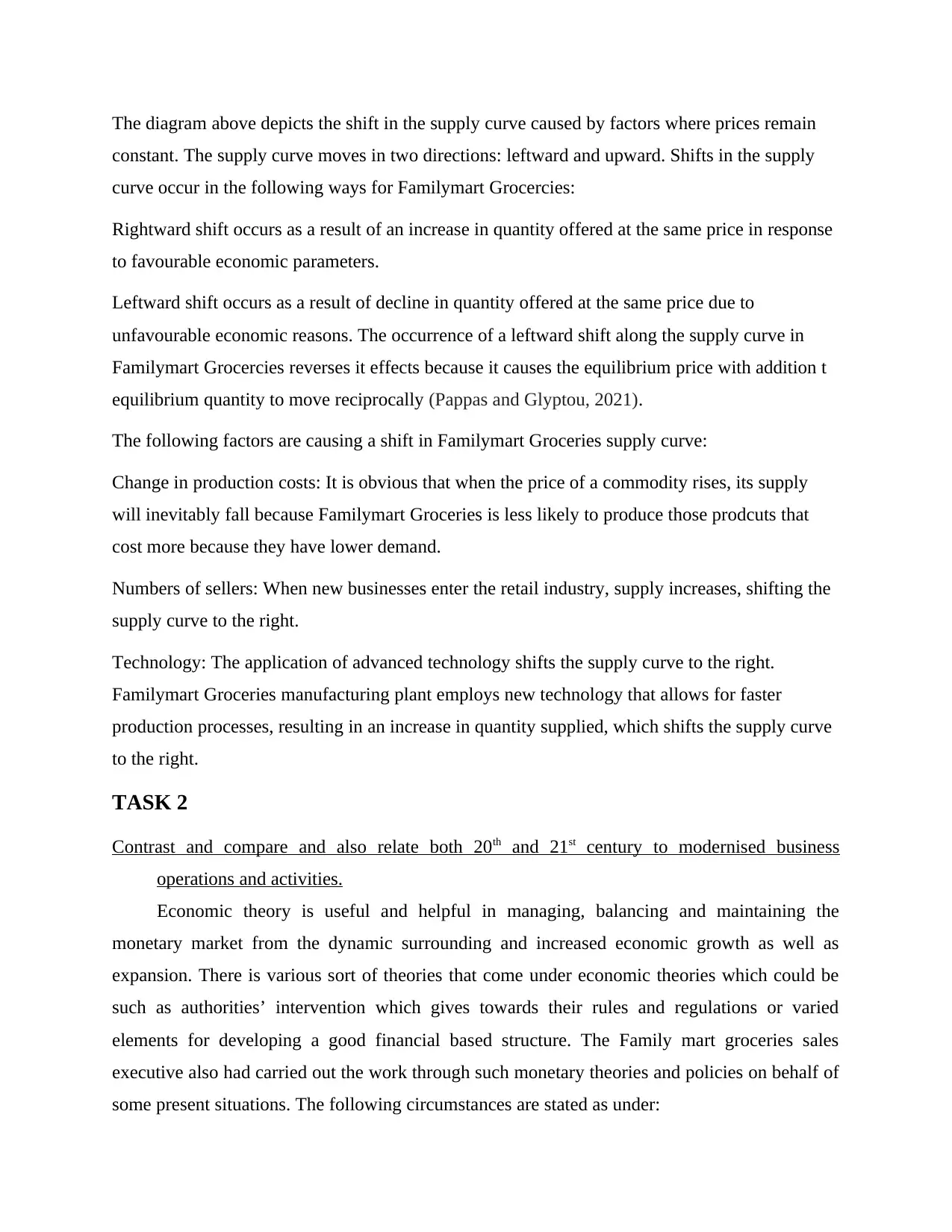
The diagram above depicts the shift in the supply curve caused by factors where prices remain
constant. The supply curve moves in two directions: leftward and upward. Shifts in the supply
curve occur in the following ways for Familymart Grocercies:
Rightward shift occurs as a result of an increase in quantity offered at the same price in response
to favourable economic parameters.
Leftward shift occurs as a result of decline in quantity offered at the same price due to
unfavourable economic reasons. The occurrence of a leftward shift along the supply curve in
Familymart Grocercies reverses it effects because it causes the equilibrium price with addition t
equilibrium quantity to move reciprocally (Pappas and Glyptou, 2021).
The following factors are causing a shift in Familymart Groceries supply curve:
Change in production costs: It is obvious that when the price of a commodity rises, its supply
will inevitably fall because Familymart Groceries is less likely to produce those prodcuts that
cost more because they have lower demand.
Numbers of sellers: When new businesses enter the retail industry, supply increases, shifting the
supply curve to the right.
Technology: The application of advanced technology shifts the supply curve to the right.
Familymart Groceries manufacturing plant employs new technology that allows for faster
production processes, resulting in an increase in quantity supplied, which shifts the supply curve
to the right.
TASK 2
Contrast and compare and also relate both 20th and 21st century to modernised business
operations and activities.
Economic theory is useful and helpful in managing, balancing and maintaining the
monetary market from the dynamic surrounding and increased economic growth as well as
expansion. There is various sort of theories that come under economic theories which could be
such as authorities’ intervention which gives towards their rules and regulations or varied
elements for developing a good financial based structure. The Family mart groceries sales
executive also had carried out the work through such monetary theories and policies on behalf of
some present situations. The following circumstances are stated as under:
constant. The supply curve moves in two directions: leftward and upward. Shifts in the supply
curve occur in the following ways for Familymart Grocercies:
Rightward shift occurs as a result of an increase in quantity offered at the same price in response
to favourable economic parameters.
Leftward shift occurs as a result of decline in quantity offered at the same price due to
unfavourable economic reasons. The occurrence of a leftward shift along the supply curve in
Familymart Grocercies reverses it effects because it causes the equilibrium price with addition t
equilibrium quantity to move reciprocally (Pappas and Glyptou, 2021).
The following factors are causing a shift in Familymart Groceries supply curve:
Change in production costs: It is obvious that when the price of a commodity rises, its supply
will inevitably fall because Familymart Groceries is less likely to produce those prodcuts that
cost more because they have lower demand.
Numbers of sellers: When new businesses enter the retail industry, supply increases, shifting the
supply curve to the right.
Technology: The application of advanced technology shifts the supply curve to the right.
Familymart Groceries manufacturing plant employs new technology that allows for faster
production processes, resulting in an increase in quantity supplied, which shifts the supply curve
to the right.
TASK 2
Contrast and compare and also relate both 20th and 21st century to modernised business
operations and activities.
Economic theory is useful and helpful in managing, balancing and maintaining the
monetary market from the dynamic surrounding and increased economic growth as well as
expansion. There is various sort of theories that come under economic theories which could be
such as authorities’ intervention which gives towards their rules and regulations or varied
elements for developing a good financial based structure. The Family mart groceries sales
executive also had carried out the work through such monetary theories and policies on behalf of
some present situations. The following circumstances are stated as under:
Secure Best Marks with AI Grader
Need help grading? Try our AI Grader for instant feedback on your assignments.
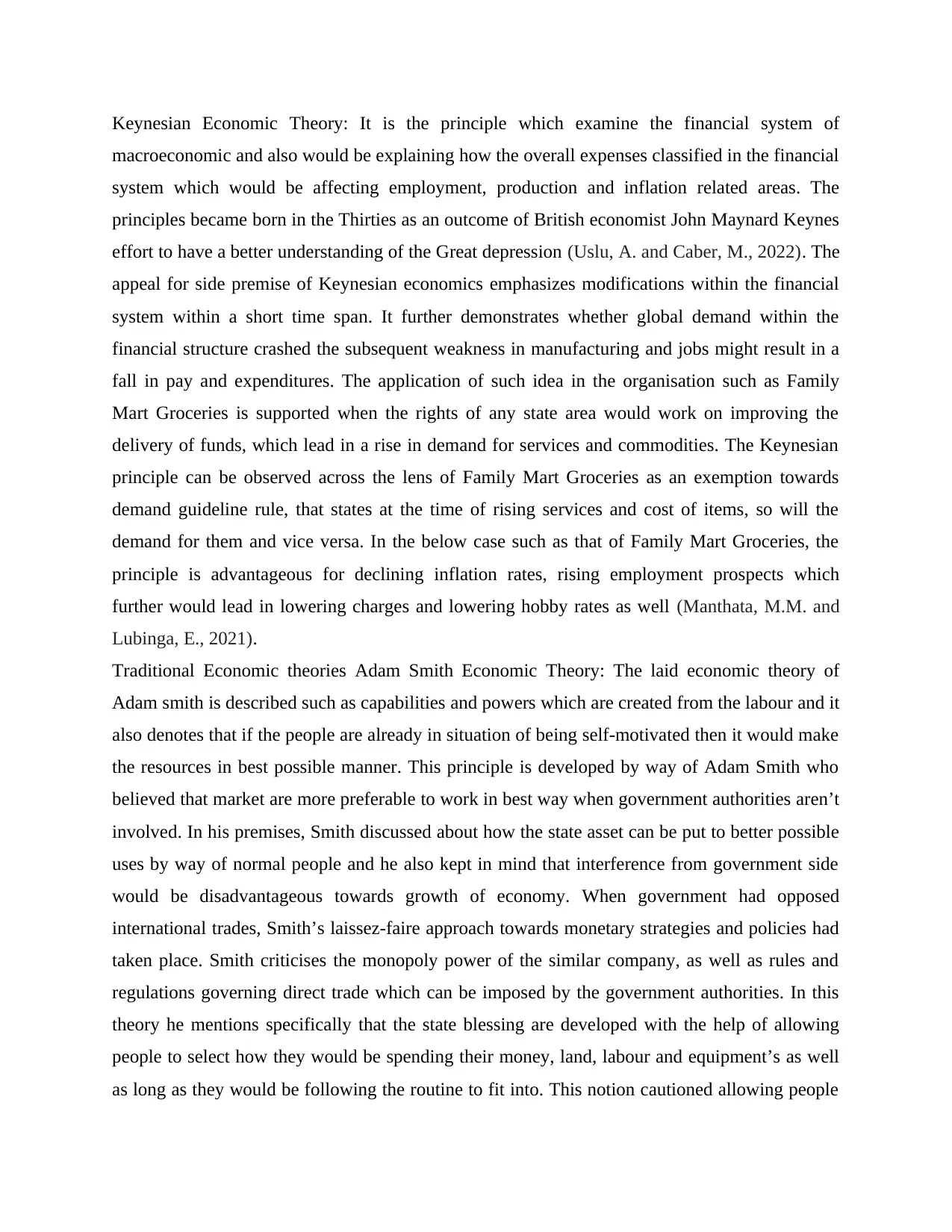
Keynesian Economic Theory: It is the principle which examine the financial system of
macroeconomic and also would be explaining how the overall expenses classified in the financial
system which would be affecting employment, production and inflation related areas. The
principles became born in the Thirties as an outcome of British economist John Maynard Keynes
effort to have a better understanding of the Great depression (Uslu, A. and Caber, M., 2022). The
appeal for side premise of Keynesian economics emphasizes modifications within the financial
system within a short time span. It further demonstrates whether global demand within the
financial structure crashed the subsequent weakness in manufacturing and jobs might result in a
fall in pay and expenditures. The application of such idea in the organisation such as Family
Mart Groceries is supported when the rights of any state area would work on improving the
delivery of funds, which lead in a rise in demand for services and commodities. The Keynesian
principle can be observed across the lens of Family Mart Groceries as an exemption towards
demand guideline rule, that states at the time of rising services and cost of items, so will the
demand for them and vice versa. In the below case such as that of Family Mart Groceries, the
principle is advantageous for declining inflation rates, rising employment prospects which
further would lead in lowering charges and lowering hobby rates as well (Manthata, M.M. and
Lubinga, E., 2021).
Traditional Economic theories Adam Smith Economic Theory: The laid economic theory of
Adam smith is described such as capabilities and powers which are created from the labour and it
also denotes that if the people are already in situation of being self-motivated then it would make
the resources in best possible manner. This principle is developed by way of Adam Smith who
believed that market are more preferable to work in best way when government authorities aren’t
involved. In his premises, Smith discussed about how the state asset can be put to better possible
uses by way of normal people and he also kept in mind that interference from government side
would be disadvantageous towards growth of economy. When government had opposed
international trades, Smith’s laissez-faire approach towards monetary strategies and policies had
taken place. Smith criticises the monopoly power of the similar company, as well as rules and
regulations governing direct trade which can be imposed by the government authorities. In this
theory he mentions specifically that the state blessing are developed with the help of allowing
people to select how they would be spending their money, land, labour and equipment’s as well
as long as they would be following the routine to fit into. This notion cautioned allowing people
macroeconomic and also would be explaining how the overall expenses classified in the financial
system which would be affecting employment, production and inflation related areas. The
principles became born in the Thirties as an outcome of British economist John Maynard Keynes
effort to have a better understanding of the Great depression (Uslu, A. and Caber, M., 2022). The
appeal for side premise of Keynesian economics emphasizes modifications within the financial
system within a short time span. It further demonstrates whether global demand within the
financial structure crashed the subsequent weakness in manufacturing and jobs might result in a
fall in pay and expenditures. The application of such idea in the organisation such as Family
Mart Groceries is supported when the rights of any state area would work on improving the
delivery of funds, which lead in a rise in demand for services and commodities. The Keynesian
principle can be observed across the lens of Family Mart Groceries as an exemption towards
demand guideline rule, that states at the time of rising services and cost of items, so will the
demand for them and vice versa. In the below case such as that of Family Mart Groceries, the
principle is advantageous for declining inflation rates, rising employment prospects which
further would lead in lowering charges and lowering hobby rates as well (Manthata, M.M. and
Lubinga, E., 2021).
Traditional Economic theories Adam Smith Economic Theory: The laid economic theory of
Adam smith is described such as capabilities and powers which are created from the labour and it
also denotes that if the people are already in situation of being self-motivated then it would make
the resources in best possible manner. This principle is developed by way of Adam Smith who
believed that market are more preferable to work in best way when government authorities aren’t
involved. In his premises, Smith discussed about how the state asset can be put to better possible
uses by way of normal people and he also kept in mind that interference from government side
would be disadvantageous towards growth of economy. When government had opposed
international trades, Smith’s laissez-faire approach towards monetary strategies and policies had
taken place. Smith criticises the monopoly power of the similar company, as well as rules and
regulations governing direct trade which can be imposed by the government authorities. In this
theory he mentions specifically that the state blessing are developed with the help of allowing
people to select how they would be spending their money, land, labour and equipment’s as well
as long as they would be following the routine to fit into. This notion cautioned allowing people
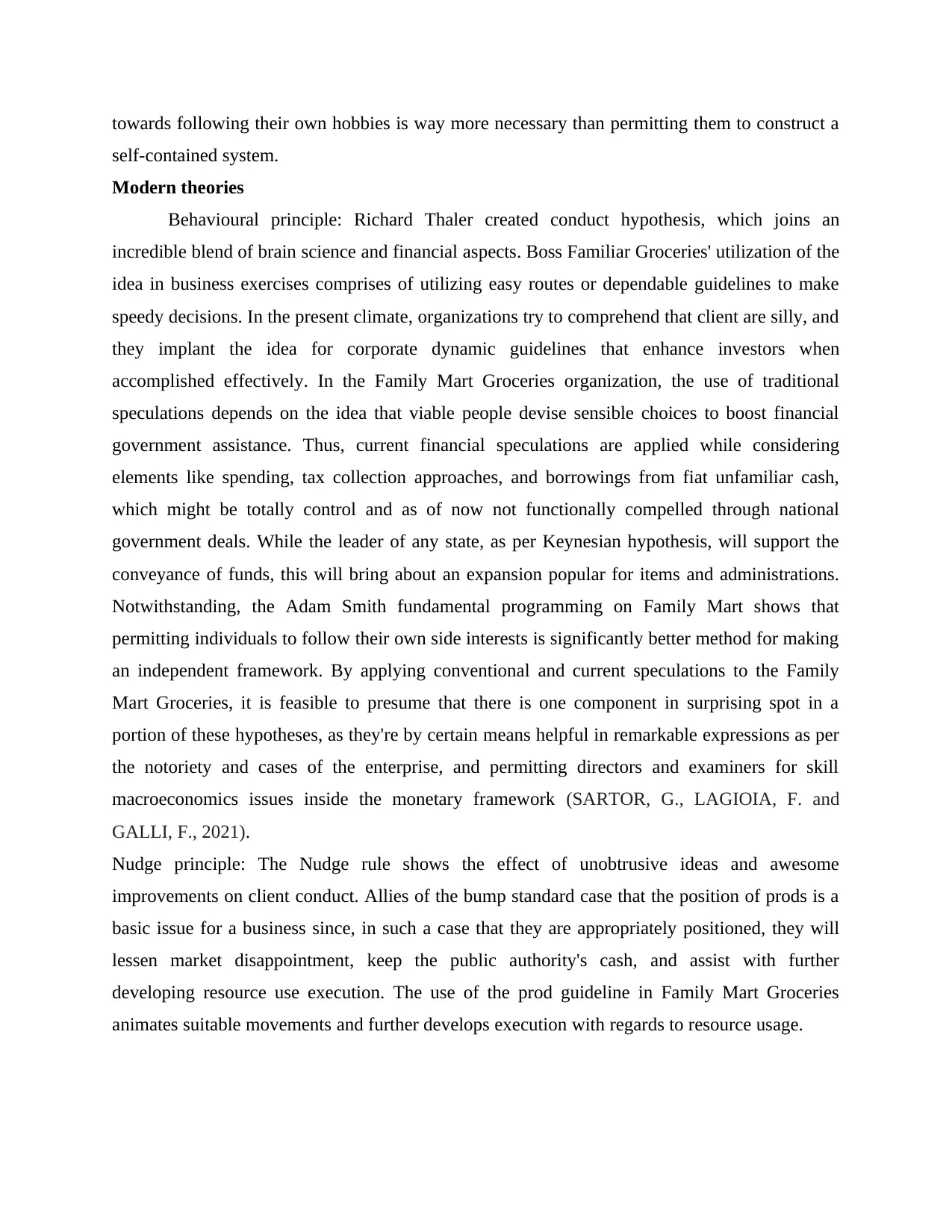
towards following their own hobbies is way more necessary than permitting them to construct a
self-contained system.
Modern theories
Behavioural principle: Richard Thaler created conduct hypothesis, which joins an
incredible blend of brain science and financial aspects. Boss Familiar Groceries' utilization of the
idea in business exercises comprises of utilizing easy routes or dependable guidelines to make
speedy decisions. In the present climate, organizations try to comprehend that client are silly, and
they implant the idea for corporate dynamic guidelines that enhance investors when
accomplished effectively. In the Family Mart Groceries organization, the use of traditional
speculations depends on the idea that viable people devise sensible choices to boost financial
government assistance. Thus, current financial speculations are applied while considering
elements like spending, tax collection approaches, and borrowings from fiat unfamiliar cash,
which might be totally control and as of now not functionally compelled through national
government deals. While the leader of any state, as per Keynesian hypothesis, will support the
conveyance of funds, this will bring about an expansion popular for items and administrations.
Notwithstanding, the Adam Smith fundamental programming on Family Mart shows that
permitting individuals to follow their own side interests is significantly better method for making
an independent framework. By applying conventional and current speculations to the Family
Mart Groceries, it is feasible to presume that there is one component in surprising spot in a
portion of these hypotheses, as they're by certain means helpful in remarkable expressions as per
the notoriety and cases of the enterprise, and permitting directors and examiners for skill
macroeconomics issues inside the monetary framework (SARTOR, G., LAGIOIA, F. and
GALLI, F., 2021).
Nudge principle: The Nudge rule shows the effect of unobtrusive ideas and awesome
improvements on client conduct. Allies of the bump standard case that the position of prods is a
basic issue for a business since, in such a case that they are appropriately positioned, they will
lessen market disappointment, keep the public authority's cash, and assist with further
developing resource use execution. The use of the prod guideline in Family Mart Groceries
animates suitable movements and further develops execution with regards to resource usage.
self-contained system.
Modern theories
Behavioural principle: Richard Thaler created conduct hypothesis, which joins an
incredible blend of brain science and financial aspects. Boss Familiar Groceries' utilization of the
idea in business exercises comprises of utilizing easy routes or dependable guidelines to make
speedy decisions. In the present climate, organizations try to comprehend that client are silly, and
they implant the idea for corporate dynamic guidelines that enhance investors when
accomplished effectively. In the Family Mart Groceries organization, the use of traditional
speculations depends on the idea that viable people devise sensible choices to boost financial
government assistance. Thus, current financial speculations are applied while considering
elements like spending, tax collection approaches, and borrowings from fiat unfamiliar cash,
which might be totally control and as of now not functionally compelled through national
government deals. While the leader of any state, as per Keynesian hypothesis, will support the
conveyance of funds, this will bring about an expansion popular for items and administrations.
Notwithstanding, the Adam Smith fundamental programming on Family Mart shows that
permitting individuals to follow their own side interests is significantly better method for making
an independent framework. By applying conventional and current speculations to the Family
Mart Groceries, it is feasible to presume that there is one component in surprising spot in a
portion of these hypotheses, as they're by certain means helpful in remarkable expressions as per
the notoriety and cases of the enterprise, and permitting directors and examiners for skill
macroeconomics issues inside the monetary framework (SARTOR, G., LAGIOIA, F. and
GALLI, F., 2021).
Nudge principle: The Nudge rule shows the effect of unobtrusive ideas and awesome
improvements on client conduct. Allies of the bump standard case that the position of prods is a
basic issue for a business since, in such a case that they are appropriately positioned, they will
lessen market disappointment, keep the public authority's cash, and assist with further
developing resource use execution. The use of the prod guideline in Family Mart Groceries
animates suitable movements and further develops execution with regards to resource usage.
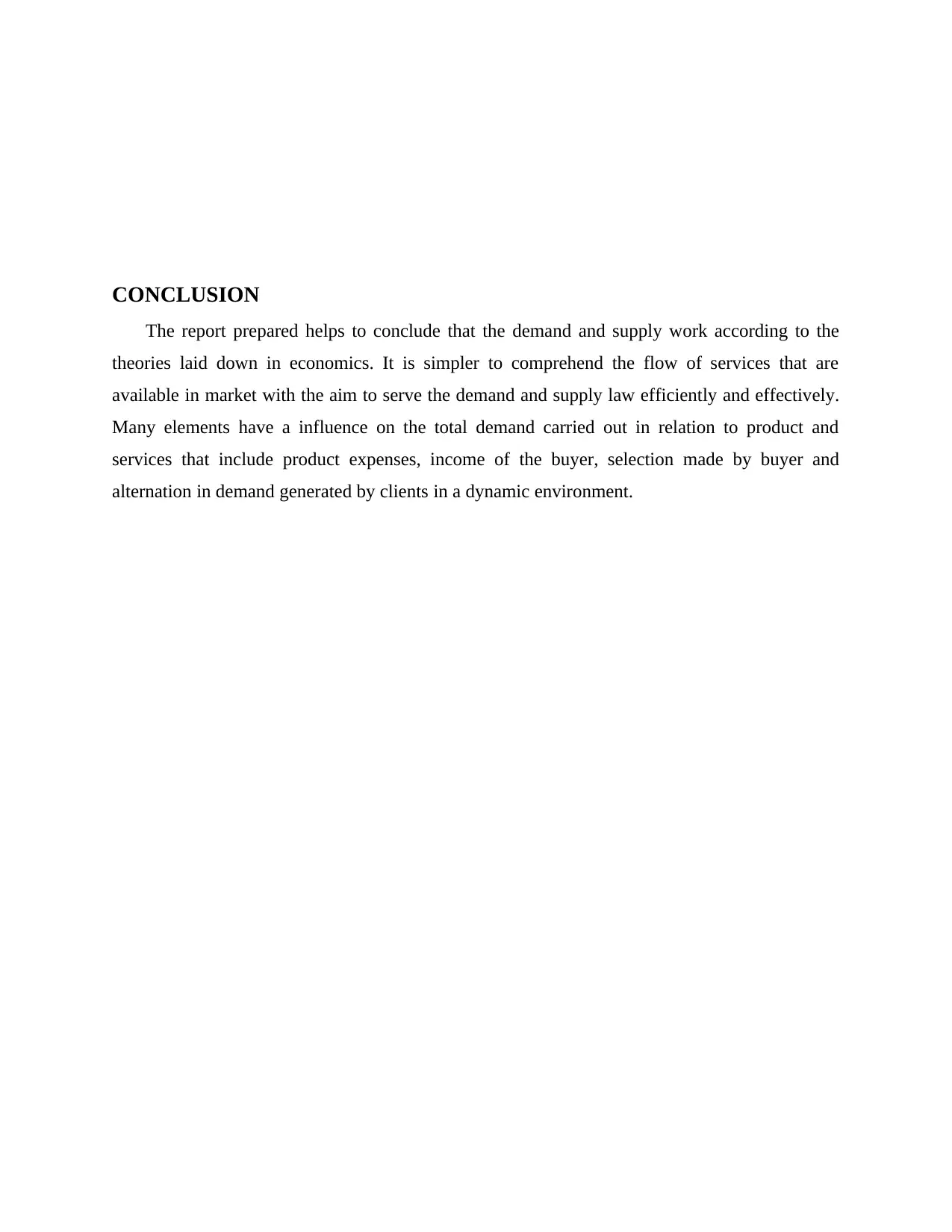
CONCLUSION
The report prepared helps to conclude that the demand and supply work according to the
theories laid down in economics. It is simpler to comprehend the flow of services that are
available in market with the aim to serve the demand and supply law efficiently and effectively.
Many elements have a influence on the total demand carried out in relation to product and
services that include product expenses, income of the buyer, selection made by buyer and
alternation in demand generated by clients in a dynamic environment.
The report prepared helps to conclude that the demand and supply work according to the
theories laid down in economics. It is simpler to comprehend the flow of services that are
available in market with the aim to serve the demand and supply law efficiently and effectively.
Many elements have a influence on the total demand carried out in relation to product and
services that include product expenses, income of the buyer, selection made by buyer and
alternation in demand generated by clients in a dynamic environment.
Paraphrase This Document
Need a fresh take? Get an instant paraphrase of this document with our AI Paraphraser
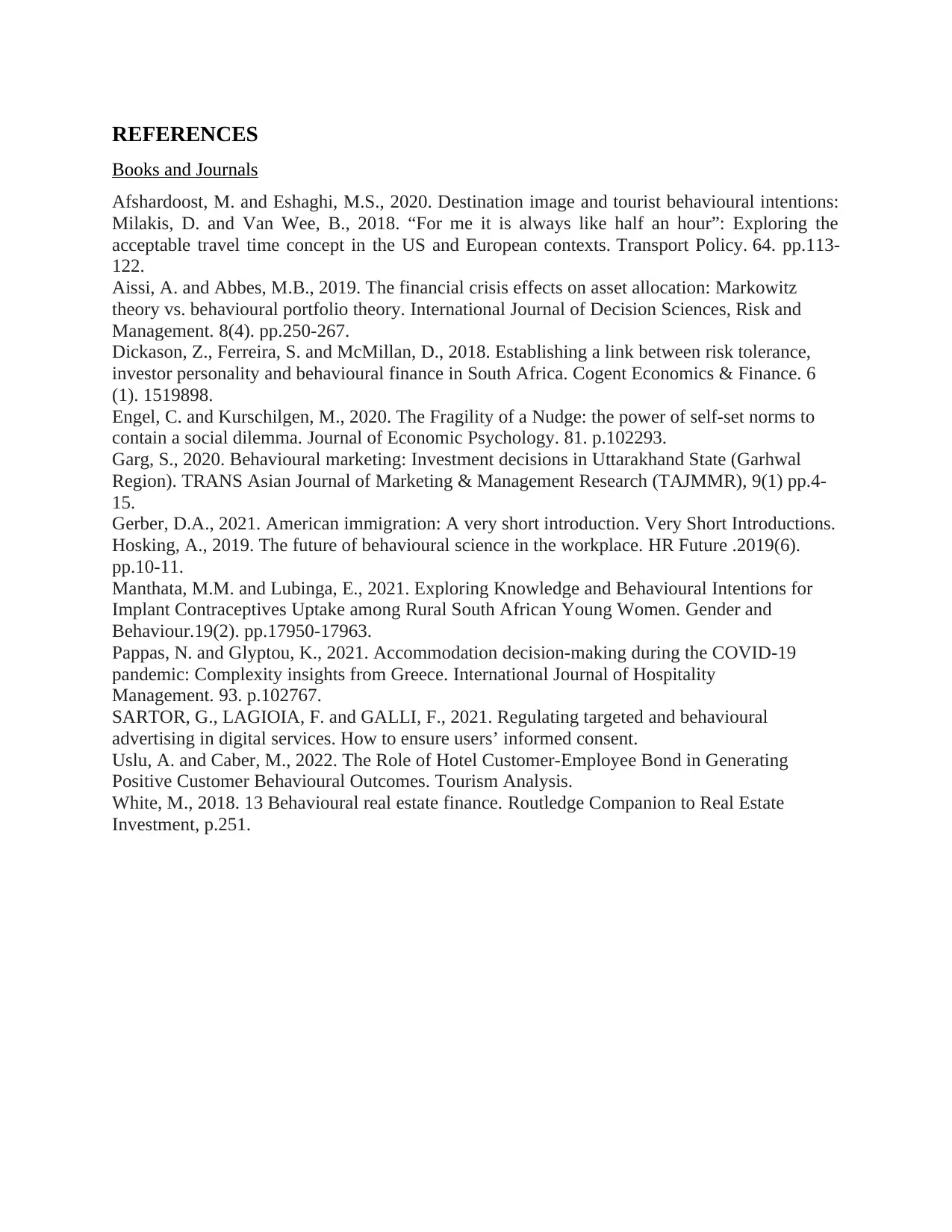
REFERENCES
Books and Journals
Afshardoost, M. and Eshaghi, M.S., 2020. Destination image and tourist behavioural intentions:
Milakis, D. and Van Wee, B., 2018. “For me it is always like half an hour”: Exploring the
acceptable travel time concept in the US and European contexts. Transport Policy. 64. pp.113-
122.
Aissi, A. and Abbes, M.B., 2019. The financial crisis effects on asset allocation: Markowitz
theory vs. behavioural portfolio theory. International Journal of Decision Sciences, Risk and
Management. 8(4). pp.250-267.
Dickason, Z., Ferreira, S. and McMillan, D., 2018. Establishing a link between risk tolerance,
investor personality and behavioural finance in South Africa. Cogent Economics & Finance. 6
(1). 1519898.
Engel, C. and Kurschilgen, M., 2020. The Fragility of a Nudge: the power of self-set norms to
contain a social dilemma. Journal of Economic Psychology. 81. p.102293.
Garg, S., 2020. Behavioural marketing: Investment decisions in Uttarakhand State (Garhwal
Region). TRANS Asian Journal of Marketing & Management Research (TAJMMR), 9(1) pp.4-
15.
Gerber, D.A., 2021. American immigration: A very short introduction. Very Short Introductions.
Hosking, A., 2019. The future of behavioural science in the workplace. HR Future .2019(6).
pp.10-11.
Manthata, M.M. and Lubinga, E., 2021. Exploring Knowledge and Behavioural Intentions for
Implant Contraceptives Uptake among Rural South African Young Women. Gender and
Behaviour.19(2). pp.17950-17963.
Pappas, N. and Glyptou, K., 2021. Accommodation decision-making during the COVID-19
pandemic: Complexity insights from Greece. International Journal of Hospitality
Management. 93. p.102767.
SARTOR, G., LAGIOIA, F. and GALLI, F., 2021. Regulating targeted and behavioural
advertising in digital services. How to ensure users’ informed consent.
Uslu, A. and Caber, M., 2022. The Role of Hotel Customer-Employee Bond in Generating
Positive Customer Behavioural Outcomes. Tourism Analysis.
White, M., 2018. 13 Behavioural real estate finance. Routledge Companion to Real Estate
Investment, p.251.
Books and Journals
Afshardoost, M. and Eshaghi, M.S., 2020. Destination image and tourist behavioural intentions:
Milakis, D. and Van Wee, B., 2018. “For me it is always like half an hour”: Exploring the
acceptable travel time concept in the US and European contexts. Transport Policy. 64. pp.113-
122.
Aissi, A. and Abbes, M.B., 2019. The financial crisis effects on asset allocation: Markowitz
theory vs. behavioural portfolio theory. International Journal of Decision Sciences, Risk and
Management. 8(4). pp.250-267.
Dickason, Z., Ferreira, S. and McMillan, D., 2018. Establishing a link between risk tolerance,
investor personality and behavioural finance in South Africa. Cogent Economics & Finance. 6
(1). 1519898.
Engel, C. and Kurschilgen, M., 2020. The Fragility of a Nudge: the power of self-set norms to
contain a social dilemma. Journal of Economic Psychology. 81. p.102293.
Garg, S., 2020. Behavioural marketing: Investment decisions in Uttarakhand State (Garhwal
Region). TRANS Asian Journal of Marketing & Management Research (TAJMMR), 9(1) pp.4-
15.
Gerber, D.A., 2021. American immigration: A very short introduction. Very Short Introductions.
Hosking, A., 2019. The future of behavioural science in the workplace. HR Future .2019(6).
pp.10-11.
Manthata, M.M. and Lubinga, E., 2021. Exploring Knowledge and Behavioural Intentions for
Implant Contraceptives Uptake among Rural South African Young Women. Gender and
Behaviour.19(2). pp.17950-17963.
Pappas, N. and Glyptou, K., 2021. Accommodation decision-making during the COVID-19
pandemic: Complexity insights from Greece. International Journal of Hospitality
Management. 93. p.102767.
SARTOR, G., LAGIOIA, F. and GALLI, F., 2021. Regulating targeted and behavioural
advertising in digital services. How to ensure users’ informed consent.
Uslu, A. and Caber, M., 2022. The Role of Hotel Customer-Employee Bond in Generating
Positive Customer Behavioural Outcomes. Tourism Analysis.
White, M., 2018. 13 Behavioural real estate finance. Routledge Companion to Real Estate
Investment, p.251.

1 out of 15
Related Documents
Your All-in-One AI-Powered Toolkit for Academic Success.
+13062052269
info@desklib.com
Available 24*7 on WhatsApp / Email
![[object Object]](/_next/static/media/star-bottom.7253800d.svg)
Unlock your academic potential
© 2024 | Zucol Services PVT LTD | All rights reserved.



